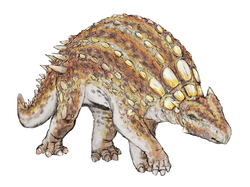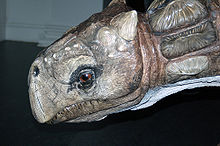- Minmi (dinosaur)
-
Minmi
Temporal range: Early Cretaceous, 119–113 Ma
Restoration Scientific classification 
Kingdom: Animalia Phylum: Chordata Class: Reptilia Superorder: Dinosauria Order: †Ornithischia Suborder: †Ankylosauria Family: †Ankylosauridae Genus: †Minmi
Molnar, 1980Species: †M. paravertebra Binomial name Minmi paravertebra
Molnar, 1980Minmi, named after Minmi Crossing, Australia (where it was found), is a genus of small ankylosaurian dinosaur that lived during the early Cretaceous Period, about 119 to 113 million years ago. The type species, M. paravertebra, was described by Ralph Molnar in 1980. A new cladistic analysis performed by Thompson et al., 2011 suggests that Minmi is the basalmost known ankylosaurid.[1]
Previously holding the record for the shortest dinosaur genus name, the title now goes to Mei, a carnivore from China that was named in 2004, and Kol, a carnivore from Mongolia that was named in 2009. Two good specimens of Minmi have been described, including a mostly complete skeleton, and additional fragments may pertain to this genus.
Contents
Discovery and species
 Model - National Dinosaur Museum, Canberra.
Model - National Dinosaur Museum, Canberra.
Minmi was found near the Minmi Crossing, in the Bungil Formation, near Roma, Queensland, Australia. It was first described in 1980 by Ralph E. Molnar, who also named the type (and only known) species.
Description
Minmi had four long (for an ankylosaurian) legs, with hind legs that were larger than front legs, a short neck and a wide skull with a very small brain. The dinosaur grew to about 2 m (10 ft) long[2] and was roughly 1 m (3 ft) tall to the top of the shoulder. Minmi probably moved relatively slowly on four legs, based on its estimated mass and its leg length as determined by scientists from fossilized tracks.
Paleobiology
Minmi was a small armoured dinosaur, classified in Ankylosauria (too primitive to be included in either the Ankylosauridae or Nodosauridae), that was quadrupedal and had a long tail. As with other ankylosaurians, Minmi was herbivorous. Unlike most herbivorous dinosaurs, there is direct evidence of the diet of Minmi: gut contents are known from the well-preserved nearly complete Minmi sp. specimen, found in the abdominal cavity in front of the left ilium. The gut contents consist of fragments of fibrous or vascular plant tissue, fruiting bodies, spherical seeds, and vesicular tissue (possibly from fern sporangia). The most common remains are the fibrous or vascular fragments, which are typically rather uniform in size at 0.6 to 2.7 millimetres (0.02 to 0.11 in) long and have clean cuts at their ends, perpendicular to a given fragment's long axis. Because of the small size of the fragments, they have been interpreted as having been nibbled from plants or chopped in the mouth, evidence of some method of retaining food in the mouth. These small fragments may have come from twigs or stems, but their size is more suggestive of vascular bundles in leaves. The clean cuts and lack of gastroliths suggest that the animal relied on oral processing instead of gastroliths or grit to grind food. The seeds (0.3 mm [0.01 in] across) and fruiting bodies (4.5 mm [0.18 in] across) were apparently swallowed whole. Comparison to gut contents and scat from modern herbivorous lizard, emu, and goose indicates that this Minmi individual had a more sophisticated process for cutting up plant material.[3]
It had bony protrusions, also known as body armour, on its head, back, abdomen, legs and along the tail. Several types of armour are known in place in Minmi sp., including small ossicles, small keeled scutes on the body, large scutes without keels on the snout, large keeled scutes on the neck, shoulders, and possibly tail, spike-like scutes on the hips, and a combination of ridged and keeled scutes and triangular plates on the tail. There was one preserved ring of scutes around the neck. The arrangement of armour is unclear on the tail, although the triangular plates may have run on the sides of the tail, with long scutes forming a row along the top of the tail.[4] However, unlike other ankylosaurians, Minmi had horizontal plates of bones that ran along the sides of its vertebrae (hence its species name, M. paravertebra).
References
- ^ Richard S. Thompson, Jolyon C. Parish, Susannah C. R. Maidment and Paul M. Barrett (2011). "Phylogeny of the ankylosaurian dinosaurs (Ornithischia: Thyreophora)". Journal of Systematic Palaeontology in press. doi:10.1080/14772019.2011.569091. http://www.tandfonline.com/doi/abs/10.1080/14772019.2011.569091.
- ^ Holtz, Thomas R. Jr. (2008) Dinosaurs: The Most Complete, Up-to-Date Encyclopedia for Dinosaur Lovers of All Ages Supplementary Information
- ^ Molnar, Ralph E.; and Clifford, H. Trevor (2001). "An ankylosaurian cololite from Queensland, Australia". In Carpenter, Kenneth (ed.). The Armored Dinosaurs. Bloomington, IN: Indiana University Press. pp. 399–412. ISBN 0-253-33964-2.
- ^ Molnar, Ralph E. (2001). "Armor of the small ankylosaur Minmi". In Carpenter, Kenneth (ed.). The Armored Dinosaurs. Bloomington, IN: Indiana University Press. pp. 341–362. ISBN 0-253-33964-2.
- The Dinosaur Age Mega, issue 4, Magazine of the National Dinosaur Museum, Canberra.
- Molnar, R. E. (1980). An ankylosaur (Ornithischia: Reptilia) from the Lower Cretaceous of southern Queensland. Memoirs of the Queensland Museum 20:65-75.
External links
Categories:- Ankylosaurs
- Cretaceous dinosaurs
- Dinosaurs of Australia
Wikimedia Foundation. 2010.

